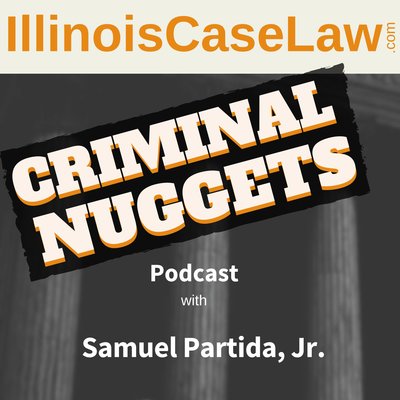Feb 27, 2015
http://IllinoisCaseLaw.com/prosecutorial-misconduct-example-they-all-do-this
What is the most common prosecutorial misconduct example or most
common prosecutorial error? Hands down in my experience that has to
be the practice of asking the judge to admit clearly inadmissible
evidence "for another purpose." Their favorite "other purpoe" is to
explain steps in a police investigation.But that's all crap.
[powerpress] Subscribe: iTunes | Stitcher | RSS![]()
This is both an old and a new issue. See People v. Boling, 2014 IL App (4th) 120634 (03/12/2014); citing People v. Cameron, 189 Ill. App. 3d 998, 1004, 546 N.E.2d 259, 263 (1989).
Downloads
I created a sample Cameron hearing motion for you to use the next time you win a motion to exclude evience. Just click the image below:
In this podcast, I also talked about how proactice prosecutors often don't accept "no" from a judge. Staying on your toes and admitting evidence through proper channels is generally a good thing. But judges are prone to letting a "bullish" prosecutor geet away with one.
Here is the kind of hearsay checklist that a prosecutor and defense attorney may use in the heat of trial battle. The good ones have it all memorized. To take a look at this thing just click below:
What Is The Most Common Prosecutorial Misconduct Example?
Ineed, the most common example of prosecutorial misconduct is subtle. This is what makes it so corrosive to the criminal justice system.
To be fair we should call it prosecutorial error. Honest prosecutors are committing this trial error. It happens, not because prosecutors are intentionally trying to circumvent justice.
Good prosecutors are trained to not give up excluded evidence. “If a judge tells you you can’t get into a line of question, find another way in.” This is how zealous prosecutors are taught. This is how they practice in an adversarial system. This is also how honest prosecutors commit the most common example of prosecutorial misconduct.
Prejudicial Hearsay Evidence
For example, a trial judge frequently excludes hearsay evidence. There can many reasons for keeping out hearsay. The hearsay could be unreliable, untrustworthy, irrelevant, OR prejudicial to the defendant.
This is what I mean by prejudicial. If the jury is allowed to hear the hearsay testimony, they almost certainly use the information inappropriately. They could jump to unjustifiable conclusions. The real damage to the system occurs when they form negative opinions about the defendant.
When the jury begins to believe that the defendant is “scum” or “slimy” they likelihood of a guilty verdict is guaranteed regardless of the strength of the actual evidence.
Admitted for Another Purpose
A tenacious, well trained prosecutor will not give up. When the state’s attorney sees that they are losing a hearsay argument, they will automatically go through a checklist. The are probing the court the another way to get into what they have already been told to stay away from.
This itself is not illegal. It is not improper. For an example of a typical hearsay admissibility checklist click here.
The most common example of prosecutorial misconduct occurs when the prosecutor settles on one argument. The argument is they are not admitting the excluded evidence for an improper reason, but merely “getting into it” for another purpose.
Typically, almost always, that other purpose is to explain to the jury why the police took the steps that they took in an investigation.
Usually, the prosecutor wants the jury to know that a criminal informant told the police that the defendant did something and that's why the police interviewed the defendant. It can be any other excluded piece of information admitted to prove why the police did something.
A judge will allow this form of “limited” evidence. The prosecutor is not allowed to go too deep into the “excluded information” and must definitely stay away from the information in closing arguments.
But, this evidence type of hearsay evidence is excluded for very strong reasons. Even a small amount of extremely prejudicial evidence will cause huge problems. Allowing The jury to sniff even a small amount of extremely prejudicial evidence causes irreversible damage.
This is how the most common example of prosecutorial misconduct happens.
[example of jury thinking or thought process?]
How to Stop The Most Common Example of Prosecutorial Misconduct
We know prosecutors are will push and probe for way to get into otherwise excluded evidence. Unfortunately, trial judges too easily give them a crack with which to enter. Until, People v. Boling, appellate courts were slow to reverse convictions when prejudicial evidence did make its way to a jury.
Defense attorneys, in many ways are the last line of defense. People v. Boling should be known, copied and ready to be thrown around the courtroom when the prosecution begins to get into excluded evidence to explain police action.
Additionally, one mode of defense may include a pretrial motion argued at the same time the court is making its findings on the inadmissible evidence. The motion would simply be asking the judge to be specific about the scope of its ruling.
Judge, the defense is also asking that the court prevent the prosecution from admitting this prejudicial evidence for any other purpose. May we proceed to a Cameron hearing, now before trial?
-This sort of thing.
Download a sample “Cameron Hearing Motion in
Limine”
that I created. It can be used to prevent a prosecutor from going
where she ought not go.
I hope you find my information on the most common example of prosecutorial misconduct helpful. The true danger in this example is not that immoral prosecutors are running rampant with this error. The situation is worse than than that. Honest prosecutors are also engaging in this mistake.
Podcast Summary
This is a general outline of the major points covered in this podcast episode:
- Discuss a Proper Example of Admitting Evidence for Another Purpose
- Discuss an Improper Example of Admitting Evidence for Another Purpose
- People v. Boling Mentions 25 Years of Prosecutorial Misconduct
- Why the Most Common Example of Prosecutorial Misconduct Happens
- Prosecutors Don’t Give Up (Download a typical checklist to admit hearsay)
- Judges Do an Incomplete Analysis (Cameron Hearing Takes to Long)
Downloads
In case your still interested. Here are the links to the available legal resources I mentioned above. If you want to take a look at a sample Motion in Limine (Cameron Hearing) just click the link.
Finally, if you want to see a sample hearsay admissibility checklist used by attorneys in to prepare for a court battleclick here.




